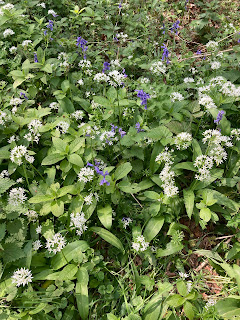Wild Garlic
This blog is about a recent trip to Lower Wood Ashwellthorpe, a Norfolk Wildlife Trust reserve, to look at ancient woodland indicators. One of these is Wild Garlic or Ramsons (Allium ursinum).
These beautiful white flowers coat the woodland floor during spring, and have a strong garlic scent, making them difficult to miss. Each flower has 6 bright white petals and cluster in groups of around 25 on the end of the stems, appearing like pompoms. Flowering early in the spring allows the plants to make the most of the sunlight reaching the forest floor before the canopy emerges and it is much shadier.
Wild Garlic is in the same family (Alliaceae) as onions, chives, leeks, daffodils, and other garlics. It reproduces by bulb division and occasionally seeds. It provides an important nectar source for early pollinators and the bulbs are eaten by Wild Boar (Sus scrofa), though these are not found at Ashwellthorpe. The species name ursinum refers to Brown Bears, which once used to live in the UK before they were hunted to extinction, and used to love eating the bulbs.

A carpet of Wild Garlic flowers at Ashwellthorpe.
This plant favours shady, damp conditions, so is mostly found in woodland. As it takes a long time to mature and dislikes disturbance, it can be used to indicate that where it grows could be ancient woodland, a critical habitat for many species. When many ancient woodland indicator species are present, there is a strong likelihood that the woodland has been around for many centuries, though this can be proven by looking at historical maps. See my previous blogs on Bluebells and Spindle for more facts about other ancient woodland indicator species.
Wild Garlic is a popular plant for foraging, the leaves can be eaten raw in salads or used in cooking to replace shop-bought garlic- they make a tasty pesto! The flowers are edible too, and are used for decorating salads. The bulbs have traditionally been used to treat rhematic problems and high cholesterol.If you are interested in trying to make your own Wild Garlic pesto, try this recipe from the Woodland Trust: Foraging and How to Make Wild Garlic Pesto - Woodland Trust . Always make sure you have permission to forage from the land owner!




Comments
Post a Comment